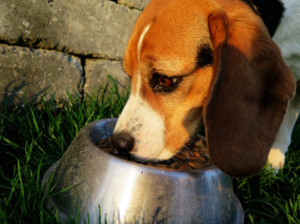You may be looking for tips on how you can feed your new puppy. Fortunately, there are many articles and videos online explaining the nutritional needs of the specific breed that you may have. But one important thing to keep in mind is that a puppy’s nutritional needs are way different than adult dogs. They need to have lots of vitamins and nutrients to speed up their growth and fuel their energy.
Know that your puppy does not just need food made exclusively for them. You can still feed your pup with the commercially prepared, high-quality, and premium dog food that is meant for all stages of life in a dog. Read more about the best ways to feed your pup in this link: https://pets.webmd.com/dogs/guide/best-dog-food-choices#1.
To guide you, the number of feedings that you need to do are the following:
- Ages 2 to 3 months should be given at least 4 meals a day
- Ages 3 to 6 months should have about 3 meals a day
- Ages 6 months to 1 year (24 months to larger breeds) means 2 meals a day
The pups can be weaned from drinking their mother’s milk, or you can get into substitute by about 4 weeks. Once this weaning process has started, you may want to be patient because it will take about 3 weeks for them to transition away from their mother’s milk.
You need to get them to be used to eating solid food. It’s best to add moisture with enough warm water so you can achieve a soupy or gruel substance. Know that your pup may take some weeks before they actually eat well because they tend to play with their gruel. You may want to do plenty of encouragement. Try to dip your hands in the food and have them lick this.
Balanced Diet is Important

Your dog needs to receive a nutritious and well-balanced diet. Read more about nutrition on this site here. This can be prepared according to your vet’s instructions, and you can also prepare these in advance before you leave for work. Balanced nutrition will keep diseases off your pup, maintain their energy, keep their mind sharp, and help them with their growth. Some of the words that you need to look at in the labels are the following:
- Balanced and complete nutrition exclusively made for pups
- The nutritional requirements are approved by the AAFCO
- Balanced and complete nutrition based on clinical trials conducted by AAFCO
Some of the key nutrients to look for are the following:
Rich in Proteins: The proteins will help build bones and tissues
Have Healthy Fats: Fats are responsible for keeping the hair and skin healthy, and they are the keys for your pet to develop good eyesight and a healthy brain.
Source of Carbohydrates: Carbs will give your pet much-needed energy for them to play all day.
Plenty of Minerals and Vitamins: There’s a balanced and complete food suitable for all puppies because they contain vitamins and minerals.
Lots of Water: Choose food that contains almost 78% water, but it’s still best if they can have sources of water that’s clean and always available to them.
What to Feed your Pup?

The decisions you’re making for your puppies while still young will affect their development, overall health, growth, and even their behavior.
When you decide to feed them high-quality food, you’re making them have a great start in life because you’re meeting a puppy’s nutritional needs. They will get the energy and nutrition they need from premium food like the one in HungryBark.com, where you can also get more information about what to feed your loveable pet. Other guides that may help you are the following:
Small and Large
Puppies don’t only need food that’s specific for them, but they can also benefit from the ones made for their breeds and sizes. Many companies usually manufacture particular formulas, and this is something that you should take advantage of.
If you’re adopting a larger breed, you need to choose products for giant dogs, complete with chicken and rice. They usually provide mobility and healthier joints. Some products promote brain-supporting nutrients with a blend of arginine, B vitamins, anti-oxidants, EPA, and DHA to increase the mental sharpness of the canines.
There are also choices for rice entrée chunks, beef, and gravy flavors available which your puppy will love. Most canines can’t resist eating some tender chunks combined with delicious gravy. If possible, select food rich in phosphorus and calcium so that the puppies will grow with stronger teeth and bones. If you notice that your pup has certain sensitivities, get the rice and salmon formula that’s rich in omega-6 fatty acids, rice, and sunflower to boost the immune system.
The difference in the formula lies in the fact that small and large breeds have their own unique needs. Larger canines often have a high risk of arthritis, back pain, and other joint issues. This is why they should include the proper nutrients that will support the health and growth of their joints. On the other hand, the small ones may prefer tiny kibbles, which can help them chew easier, so they’ll get the vitamins that they need.
The smaller ones have a faster metabolism than the larger breeds. This means that you should give them higher-energy food that is dense in nutrients. You can browse through the web or ask the veterinarian about the recommended products you should provide for your furry friend.
Wet vs. Dry

Some dry kibbles and treats are popular choices for many pet parents. This can allow them to bring the treats while they go for a walk. However, if you walk down further in the grocery aisle, you may see vast selections of wet food for your pups.
It can be hard to decide which one is best for your growing pup. Fortunately, both choices can be good as long as the dry and wet formulas have complete nutrition, and they will be able to provide a balanced diet for your pup. Feed one when you’re at home and the other when you’re out for a walk. Consider your pet’s preferences as well, and they can give you cues about the formula that they prefer when it’s feeding time.
There are combinations that you should consider as well. You can feed some dry amounts to provide them the calories that they need. Generally, a 3-ounce can of wet food may contain about 9 calories. This can be approximately a ¼ cup of dry food. There’s information on the labels that you may want to read first to guide you. Develop a feeding plan and ensure that your dog maintains an ideal body condition while growing.
The Amount of Food to Feed
Now that you have an idea about the food you can give to your pet, you may start wondering how much food you should give every day?
Know that the growth rate of pups is faster than their adult counterparts. They should start eating a complete and balanced diet as soon as they wean from their mother’s milk. As stated, this usually happens between six to eight weeks.
The amount of food will depend on its overall weight upon maturity. For example, a Russell Terrier will weigh less than a Labrador Retriever. The larger they are, the more they will need to eat when they are younger. There are feeding charts that can give you an idea about the amount of food your canine should receive depending on their weight at maturity and the cups they need as adults, so be sure to check them out.
Feeding Schedules
Once you have an idea of the cups to give, you will then need to create a schedule. You should take the time to divide portions and ensure that they are full after each meal. Regular intervals with smaller amounts of food can be ideal in some breeds.
You can include him in your schedule when you eat your regular breakfasts, lunches, and dinners. You need to feed him early in the evening to have time to process and digest the meals before bedtime. He can also sleep better when he is full.
Twilight feeding can prevent accidents inside his digestive system and ensure that you’re consistent. Getting him to eat at specific hours of the day will help him get used to the routine inside the home, and he will know what to expect. Another thing is that it’s also going to be easier for both of you when feeding is second nature to you, especially if you have a busy schedule.
You’ve been schooled on types of dog food, what to look out for when selecting the right nutrition for your dog, NOW don’t miss our post on The Top Rated Organic Dog Food Brands in 2021.
Love our content? Share it with a friend or link it to social media. Like short clips of cute household pets? Training tips? Follow us on instagram @nydognanny or on YouTube at nydognanny. Have some news you needs to get to dog and cat parents stat? Email info@newyorkdognanny.com with your article pitch.




